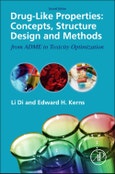Of the thousands of novel compounds that a drug discovery project team invents and that bind to the therapeutic target, only a fraction have sufficient ADME (absorption, distribution, metabolism, elimination) properties, and acceptable toxicology properties, to become a drug product that will successfully complete human Phase I clinical trials. Drug-Like Properties: Concepts, Structure Design and Methods from ADME to Toxicity Optimization, Second Edition, provides scientists and students the background and tools to understand, discover, and develop optimal clinical candidates. This valuable resource explores physiochemical properties, including solubility and permeability, before exploring how compounds are absorbed, distributed, and metabolized safely and stably. Review chapters provide context and underscore the importance of key concepts such as pharmacokinetics, toxicity, the blood-brain barrier, diagnosing drug limitations, prodrugs, and formulation. Building on those foundations, this thoroughly updated revision covers a wide variety of current methods for the screening (high throughput), diagnosis (medium throughput) and in-depth (low throughput) analysis of drug properties for process and product improvement. From conducting key assays for interpretation and structural analysis, the reader learns to implement modification methods and improve each ADME property.
Through valuable case studies, structure-property relationship descriptions, and structure modification strategies, Drug-Like Properties, Second Edition, offers tools and methods for ADME/Tox scientists through all aspects of drug research, discovery, design, development, and optimization.
Please Note: This is an On Demand product, delivery may take up to 11 working days after payment has been received.
Table of Contents
1. Introduction 2. Benefits of Property Assessment and Good Drug-Like Properties 3. In Vivo Environments Affect Drug Exposure 4. Prediction Rules for Rapid Property Profiling from Structure 5. Lipophilicity 6. pKa 7. Solubility 8. Permeability 9. Transporters 10. Blood-Brain Barrier 11. Metabolic Stability 12. Plasma Stability 13. Solution Stability 14. Plasma and Tissue Binding 15. Cytochrome P450 Inhibition 16. hERG Blocking 17. Toxicity 18. Integrity and Purity 19. Pharmacokinetics 20. Lead Properties 21. Strategies for Integrating Drug-Like Properties into Drug Discovery 22. Methods for Profiling Drug-Like Properties: General Concepts 23. Lipophilicity Methods 24. pKa Methods 25. Solubility Methods 26. Permeability Methods 27. Transporter Methods 28. Blood-Brain Barrier Methods 29. Metabolic Stability Methods 30. Plasma Stability Methods 31. Solution Stability Methods 32. CYP Inhibition Methods 33. Plasma and Tissue Binding Methods 34. hERG Methods 35. Toxicity Methods 36. Integrity and Purity Methods 37. Pharmacokinetic Methods 38. Diagnosing and Improving Pharmacokinetic Performance 39. Prodrugs 40. Effects of Properties on Biological Assays 41. Formulation








